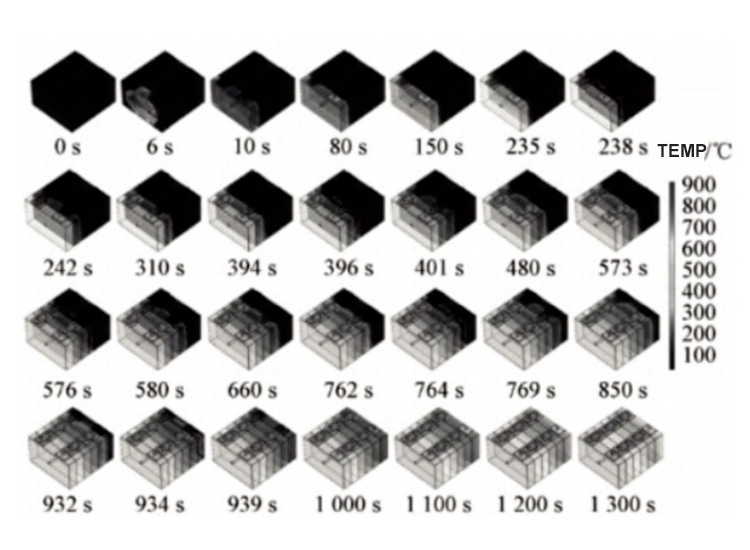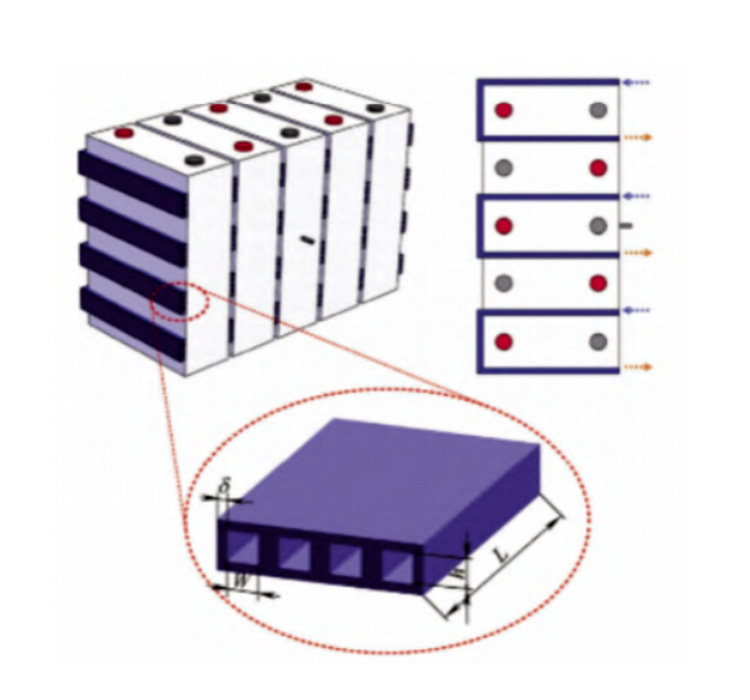In terms of battery cell thermal runaway safety technology, the following technical breakthroughs have been developed: electrolyte improvement, positive electrode material improvement, separator improvement, surface coating, pressure relief valve and PTC resistor. In terms of battery group thermal runaway, domestic and foreign research is mainly carried out in the following aspects: structural safety design, BMS safety, cooling system, active safety technology, etc.
The safety design of battery system and group structure mainly includes thermal propagation blocking design, valve drain channel design, PTC resistance and fuse design, etc. BMS security includes parameter detection, BMS equalization technology, etc. The cooling system includes air cooling, liquid cooling, phase change material cooling, etc. Active safety technology includes fire extinguishing, explosion-proof design and other technologies.
The thermal runaway of the battery is caused by the fact that the heat generation rate of the battery is much higher than the heat dissipation rate, and a large amount of heat is accumulated and not dissipated in time. In essence, thermal runaway is a positive feedback loop of energy: rising temperatures cause the system to heat up, which in turn makes the system hotter. Without strict division, battery thermal runaway can be divided into three stages:
Stage 1: The battery internal thermal runaway stage
Due to internal short circuit, external heating, or the battery itself heats up during high current charging and discharging, the internal temperature of the battery rises to about 90 ° C ~ 100 ° C, and lithium salt LiPF6 begins to decompose; The chemical activity of the carbon cathode in the charging state is very high, close to lithium metal, the SEI film on the surface is decomposed at high temperature, and the lithium ion embedded in graphite will react with the electrolyte and binder, further pushing the battery temperature up to 150℃, at this temperature there are new violent exothermic reactions, such as a large amount of electrolyte decomposition. PF5 was generated, and PF5 further catalyzed the decomposition of organic solvents.
Stage 2: Battery bulge stage
When the battery temperature reaches above 200 ° C, the positive electrode material decomposes, releasing a lot of heat and gas, and it continues to heat up. At 250-350℃, the Li-embedded negative electrode began to react with the electrolyte.
Stage 3: Battery thermal runaway, explosion failure stage
In the process of reaction, the charged cathode material begins to undergo a violent decomposition reaction, the electrolyte undergo a violent oxidation reaction, release a lot of heat, produce high temperature and a lot of gas, and the battery burns and explodes.
Thermal runaway prevention measures and methods
With the aim of blocking, delaying and preventing thermal runaway of power batteries, many scholars have conducted researches based on thermal management of battery packs and structural design of high-intensity battery packs.
▌ Safety Design for a Single battery
(1) Safety study of separator design
The core of improving the safety of the separator is to increase the temperature of the separator contraction and melting decomposition, and enhance the isolation ability under high temperature conditions. The high temperature isolation ability of the separator ensures that the separator micropores are closed in a high temperature environment and block the outflow of lithium ions. The widely used separator materials are generally covered with ceramic coatings or other materials with closed cell effect.
(2) Safety research of positive electrode materials
The most common lithium ion positive active materials in the power battery market are generally LiCoO2, LiFePO4, LiMn2O4, LiNixCoyMnzO2 (NCM) and so on. Use material to cover the positive electrode to block and slow the thermal runaway side reaction, improve the battery cycle and thermal stability, such as ZrO2 and AlF3.
(3) Research on the safety of anode materials
The safety of the negative electrode is improved mainly by material coating or adding additives to the electrolyte to improve the thermal stability of SEI film. Liquid alloy GaSnIn was added to the electrolyte to improve the thermal stability of the battery. The experiment shows that the prepared gradient SEI layer greatly reduces the voltage polarization and improves the coulomb efficiency to 99.06%. An ultra-thin aramid nanofiber (ANF) film was prepared to inhibit the growth of lithium dendrites. In the experimental test, at a high current density of 50 mA/ cm2, the capacity of ANF-Li | LiFePO4 full battery decays to 80.2% after 1200 cycles. Moreover, the study found for the first time that the fibrous lithium deposition, the nanoscale void of ANF membrane promoted the diffusion of electrolyte, accelerated the efficiency of lithium transport, and eliminated the disadvantages of micron-scale lithium dendrites penetrating the diaphragm.
(4) Electrolyte safety research
Most of the thermal runaway accidents involve the electrolyte, so it is very important to improve the safety of the electrolyte and prevent the thermal runaway. Anti-overcharge additives such as flame retardants, solid polymeric substances or ionic liquids are often added to the electrolyte. Ethylene fluorinated carbonate (FEC) is the most common electrolyte additive, and its advantage is to improve the coulomb efficiency of reversible delithium of the negative electrode by changing the composition of the SEI film. The SEI film with double layer crystal and polymer solid electrolyte was designed in a phosphate ester electrolyte mixture with lithium difluoroborate (LiDFOB) as main salt. The flame retardant experiment shows that the self-extinguishing time of the flame retardant electrolyte is 6.1s, the reversible efficiency of Li is 98.2%, and the battery capacity is still 89.7% after 150 cycles of charge and discharge.
▌ Safety protection and optimal design of power battery systems
(1) Battery pack structure optimization design
Battery pack structure design and vehicle installation location optimization are crucial to improve safety. Based on the battery arrangement of model 18650, the effects of thermal runaway range were classified. The experiment shows that the ignition time of the area with larger heating area is shorter and the spreading speed and range are larger. However, the experiment only considers the overall heating of the power battery module and does not consider the local overheating caused by the internal short circuit. The battery pack design was optimized based on the three-dimensional heat dissipation model of the power battery pack, and the heat dissipation simulation was carried out. The experiment shows that the peak temperature of the optimized lithium-ion battery is reduced from 46 ℃ to 34 ℃, and the temperature difference between single batteries is controlled within 5 ℃.
(2) Design of battery thermal management system
Lithium ion battery has strong thermal sensitivity, improving low temperature discharge efficiency and high temperature safety is the core of battery thermal management system. Battery pack cooling methods are liquid cooling and air cooling, Tesla produced electric vehicles are using liquid cooling technology, electric buses generally use air cooling. In recent years, aerogels, phase change materials and mixed materials have been used in battery thermal management systems due to their excellent heat absorption performance.
(3) Cooling, fire extinguishing, blocking and gas guiding design of the battery thermal runaway
When the thermal runaway of the battery is unavoidable, it is particularly important to block the cooling of the heat spread and guide the high temperature gas in time for the battery that is not affected by the installation position. The following is a 3D model of runaway thermal diffusion.

The main ways to block the thermal runaway diffusion include filling with flame retardant media, isolating the thermal runaway battery with insulation materials, or guiding the flame and high temperature gas through the path to discharge the battery pack. A researcher developed a high temperature gas heating pipe with a rectangular cross section arranged along a cell, as shown in the figure below. Although it cannot prevent the occurrence of thermal runaway of single battery, it can effectively prevent the spread of local thermal runaway of battery pack.

Sum up
Great progress has been made in the research of thermal runaway of battery cells, but safety accidents still occur at home and abroad. The role of battery system grouping technology in it needs to be further studied and verified in practice. Based on a large number of thermal runaway safety tests and battery system group design practice, in order to solve the safety problem of battery thermal runaway, the product design adopts the main circuit fuse protection, collection flow protection, safety creepage distance, electrical gap design, distributed cell external short circuit protection design, high flame retardant material application, multi-dimensional module thermal expansion structural protection, breathable and explosion-proof device, etc. Active fire extinguishing devices and other structural, electrical, active safety measures.
Contact: Jason Wang
Phone: 13580725992
E-mail: sales@aooser.com
Whatsapp:13580725992
Add: No.429 Guangming Road, Shenzhen City, Guangdong Province
We chat
